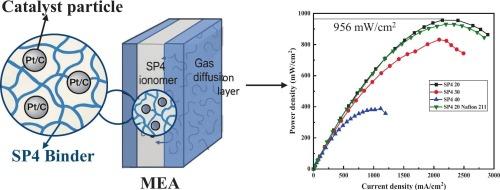High-performance sulfonated poly(arylene ether) as a catalyst binder for enhanced efficiency in proton exchange membrane fuel cells
IF 7.5
1区 工程技术
Q2 ENERGY & FUELS
引用次数: 0
Abstract
The design of high-performance catalyst binders remains a critical challenge in advancing renewable energy technologies including fuel cells and electrolyzers. Herein, we report the design and composition optimization of a novel catalyst binder, designated as SP4 (sulfonated poly(arylene ether)), tailored for proton exchange membrane fuel cells (PEMFCs). Our results reveal that among all the evaluated compositions, the SP4 20 (comprising 20 wt% SP4 ionomer in a 20 wt% methanol–water system) exhibits the highest power output, representing 15 % and 147 % improvement over SP4 30 and SP4 40 formulations, respectively. Microstructural analysis of SP4 20 reveals a highly uniform catalyst dispersion and an interconnected porous architecture within the catalyst layer (CL), which allows efficient reactant diffusion and maximizes electrochemically active surface area (54.01 m2/g). When paired with the SP4 membrane, the integrated membrane electrode assembly (MEA) achieves a peak power density of 956 mW/cm2, outperforming Nafion-based MEA (931 mW/cm2) and highlighting the benefits of membrane-electrode compatibility. Comparative analysis with contemporary binder systems reported in the literature indicates that SP4 delivers superior performance, which establishes it as one of the most promising ionomer binders developed to date. These findings designate SP4 as a high-performance and structurally optimized ionomer binder with considerable potential for next-generation PEMFC systems.

高性能磺化聚芳醚作为质子交换膜燃料电池的催化剂粘合剂
高性能催化剂粘合剂的设计仍然是推进可再生能源技术(包括燃料电池和电解槽)的关键挑战。本文报道了一种新型质子交换膜燃料电池(pemfc)催化剂粘合剂SP4(磺化聚(芳烯醚))的设计和成分优化。我们的研究结果表明,在所有评估的组合物中,SP4 20(在20 wt%的甲醇-水体系中含有20 wt%的SP4离聚体)表现出最高的功率输出,分别比SP4 30和SP4 40配方提高了15%和147%。SP4 20的微观结构分析表明,SP4 20具有高度均匀的催化剂分散和催化剂层(CL)内相互连接的多孔结构,从而允许有效的反应物扩散并最大化电化学活性表面积(54.01 m2/g)。当与SP4膜配对时,集成膜电极组件(MEA)的峰值功率密度为956 mW/cm2,优于基于nafon的MEA (931 mW/cm2),并突出了膜电极相容性的优点。与文献中报道的当代粘合剂系统的比较分析表明,SP4具有优越的性能,这使其成为迄今为止开发的最有前途的离聚体粘合剂之一。这些发现表明SP4是一种高性能、结构优化的离子聚合物粘合剂,在下一代PEMFC系统中具有相当大的潜力。
本文章由计算机程序翻译,如有差异,请以英文原文为准。
求助全文
约1分钟内获得全文
求助全文
来源期刊

Fuel
工程技术-工程:化工
CiteScore
12.80
自引率
20.30%
发文量
3506
审稿时长
64 days
期刊介绍:
The exploration of energy sources remains a critical matter of study. For the past nine decades, fuel has consistently held the forefront in primary research efforts within the field of energy science. This area of investigation encompasses a wide range of subjects, with a particular emphasis on emerging concerns like environmental factors and pollution.
 求助内容:
求助内容: 应助结果提醒方式:
应助结果提醒方式:


